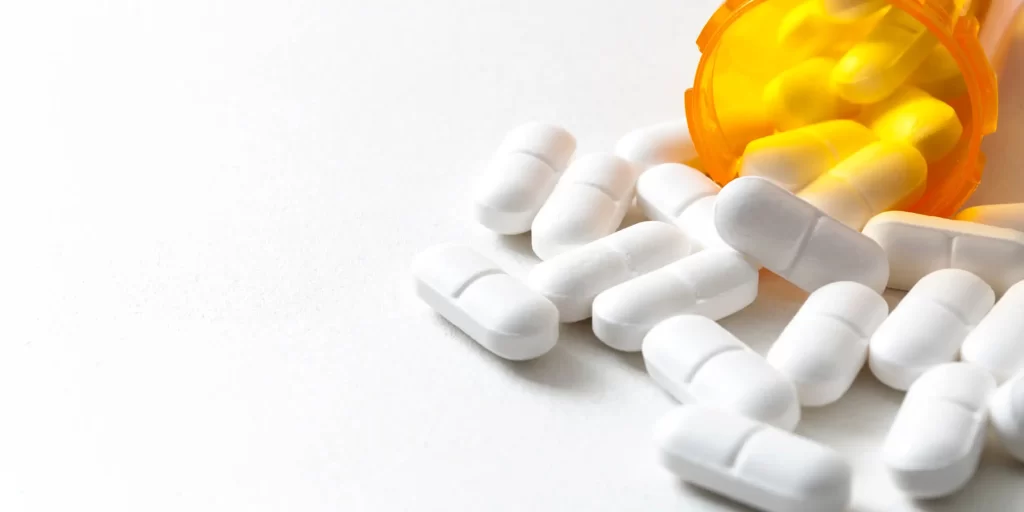Vicodin Overdose Signs & Symptoms
Written by Thomas Christiansen
& Medically Reviewed by Dr. Annie Tye, PhD
Medically Reviewed
Up to Date
Last Updated - 6/17/2022
View our editorial policy
Vicodin is a brand name for the drug combination hydrocodone and acetaminophen. Vicodin is an opioid that is prescribed to manage severe pain, but it is frequently misused. Despite the complications that regular hydrocodone/acetaminophen use is associated with, it was the sixth-most prescribed drug in the first quarter of 2019, and the most commonly prescribed opioid.
Can You Overdose on Vicodin?
Even relatively low doses of Vicodin are associated with some risk of potentially lethal overdose. More than 14,000 deaths were associated with natural and semisynthetic (including Vicodin) prescription opioid overdoses in 2017. Notably, Florida led the country in prescription opioid-related deaths with 1,133 and California reported the second-highest death rate with 973 deaths.
How Much Vicodin Does it Take to Overdose?
The amount of Vicodin needed to overdose varies per person. There are three different formulations of Vicodin, that house 5 mg, 7.5 mg and 10 mg of hydrocodone per pill. All Vicodin formulations include 300 mg of acetaminophen per pill. Hydrocodone and acetaminophen each have serious side effects associated with an overdose. Prescribed hydrocodone doses are generally between 5 to 10 mg every four to six hours.
It is difficult to determine a precise overdose amount, but even 10 mg has been reported to cause dizziness and lightheadedness in some people. Lethal doses of hydrocodone may be as low as 90 mg (10 to 20 pills depending on the formulation), especially when used with alcohol or other drugs.
Hydrocodone is not the only compound in Vicodin associated with serious, potentially lethal, consequences. Acetaminophen overdoses can have long-term health consequences. Acetaminophen toxicity is the second most common cause of liver transplants. Non-lethal acetaminophen overdose can occur with doses as low as 4 g (4,000mg). Each Vicodin pill has 300 mg acetaminophen, so 13 pills are sufficient enough to cause overdose symptoms.
Symptoms of a Vicodin Overdose
Because Vicodin is a combination of hydrocodone and acetaminophen, there are two drugs that can cause overdose symptoms. Hydrocodone overdose symptoms are associated with dizziness, muscle weakness, lethargy, stupor, confusion and memory loss. Signs and symptoms of acetaminophen toxicity may develop over the course of several days. Early symptoms of an acetaminophen overdose include nausea and lethargy. Over the course of a few days, symptoms progress to pain in the upper right side of the abdomen, lightheadedness, extreme weakness, lethargy and confusion.
Signs of a Vicodin Overdose
Signs of hydrocodone (which is part of Vicodin) overdose include:
- shallow or labored breathing
- slow heart rate
- clammy skin
- tremors
- vomiting
- fever
Signs of an acetaminophen overdose include:
- vomiting
- dark or bloody urine
- yellowing of the skin and eyes
- rapid and shallow breathing
- shaking
- coma
In extreme cases, Vicodin overdoses can cause respiratory depression that leads to coma or death. As with acetaminophen overdose symptoms, signs of acetaminophen overdose may develop over the course of a few days.
If a Vicodin overdose is suspected, call 911 immediately.
Vicodin Overdose Prevention
The best way to prevent a Vicodin overdose is to not take the drug. If you are prescribed Vicodin, follow the prescription’s instructions. Because regular use of Vicodin is strongly associated with the development of dependence and addiction, it should not be used for more than a few weeks at a time. Long-term use of Vicodin is not only associated with addiction, but the rapid development of tolerance means that the prescribed dose loses efficacy as a pain reliever, which may precipitate Vicodin misuse.
Alcohol and over-the-counter (OTC) medications can interact with Vicodin in potentially dangerous ways. For example, diphenhydramine (the active ingredient in Benadryl and some OTC sleeping pills) has a sedative effect that can potentiate the CNS depressant activity of Vicodin.
Vicodin Overdose Treatment
Because Vicodin has two active ingredients (the opioid hydrocodone and the pain reliever acetaminophen) that are dangerous at high doses, treatment for Vicodin overdose is likely to include two independent therapeutic avenues. The most immediate concern associated with hydrocodone overdose is ensuring that the patient is breathing normally. If they are not, assisted ventilation will be provided. In some cases, an opioid antagonist called naloxone will be administered. Opioid antagonists block the effects of opioids. Acetaminophen overdose can cause hepatotoxicity (liver damage) by depleting an antioxidant called glutathione in the liver. If an acetaminophen overdose is suspected, N-acetylcysteine (NAC) will be administered to rapidly replenish glutathione and stave off further liver damage. Activated charcoal may also be administered to prevent further acetaminophen absorption.
If you struggle with a substance use disorder, contact The Recovery Village Ridgefield to speak with a representative about how professional treatment can help you address your addiction and any co-occurring mental health disorders. You deserve a healthier future, call today.
Sources
Paavola, Alia. “10 most prescribed drugs in the US in Q1.” Becker’s Hospital Review, May 2019. Accessed August 5, 2019.
Kaiser Family Foundation. “Opioid Overdose Deaths by Type of Opioid.” January 2019. Accessed August 5, 2019.
Drugs.com. “Vicodin Dosage.” August 2018. Accessed August 5, 2019.
Agrawal, Suneil; Khazaeni, Babak. “Acetaminophen Toxicity.” NCBI StatPearls, November 2018. Accessed August 5, 2019.
Drugs.com. “Hydrocodone.” January 2019. Accessed August 5, 2019.
Drugs.com. “Acetaminophen Overdose.” June 2019. Accessed August 5, 2019.
Volkow, Nora D; McLellan, Thomas A. “Opioid Abuse in Chronic Pain — Misconceptions and Mitigation Strategies.” The New England Journal of Medicine, March 2016. Accessed August 5, 2019.
Howard, Paul; Twycross, Robert; Shuster, John; Mihalyo, Mary; Wilcock, Andrew. “Benzodiazepines.” The Journal of Pain and Symptom Management, May 2014. Accessed August 5, 2019.
Pattinson, Kyle T.S. “Opioids and the Control of Respiration.” British Journal of Anesthesia, June 2008. Accessed August 5, 2019.
Valenzuela, Fernando C. “Alcohol and Neurotransmitter Interactions.” Alcohol Health & Research World, 1997. Accessed August 5, 2019.
Drugs.com. “Drug Interactions between diphenhydramine and Vicodin.” Accessed August 5, 2019.
Heard, Kennon J. “Acetylcysteine for Acetaminophen Poisoning.” The New England Journal of Medicine, July 2008. Accessed August 5, 2019.
View Sources
Paavola, Alia. “10 most prescribed drugs in the US in Q1.” Becker’s Hospital Review, May 2019. Accessed August 5, 2019.
Kaiser Family Foundation. “Opioid Overdose Deaths by Type of Opioid.” January 2019. Accessed August 5, 2019.
Drugs.com. “Vicodin Dosage.” August 2018. Accessed August 5, 2019.
Agrawal, Suneil; Khazaeni, Babak. “Acetaminophen Toxicity.” NCBI StatPearls, November 2018. Accessed August 5, 2019.
Drugs.com. “Hydrocodone.” January 2019. Accessed August 5, 2019.
Drugs.com. “Acetaminophen Overdose.” June 2019. Accessed August 5, 2019.
Volkow, Nora D; McLellan, Thomas A. “Opioid Abuse in Chronic Pain — Misconceptions and Mitigation Strategies.” The New England Journal of Medicine, March 2016. Accessed August 5, 2019.
Howard, Paul; Twycross, Robert; Shuster, John; Mihalyo, Mary; Wilcock, Andrew. “Benzodiazepines.” The Journal of Pain and Symptom Management, May 2014. Accessed August 5, 2019.
Pattinson, Kyle T.S. “Opioids and the Control of Respiration.” British Journal of Anesthesia, June 2008. Accessed August 5, 2019.
Valenzuela, Fernando C. “Alcohol and Neurotransmitter Interactions.” Alcohol Health & Research World, 1997. Accessed August 5, 2019.
Drugs.com. “Drug Interactions between diphenhydramine and Vicodin.” Accessed August 5, 2019.
Heard, Kennon J. “Acetylcysteine for Acetaminophen Poisoning.” The New England Journal of Medicine, July 2008. Accessed August 5, 2019.
Authorship






